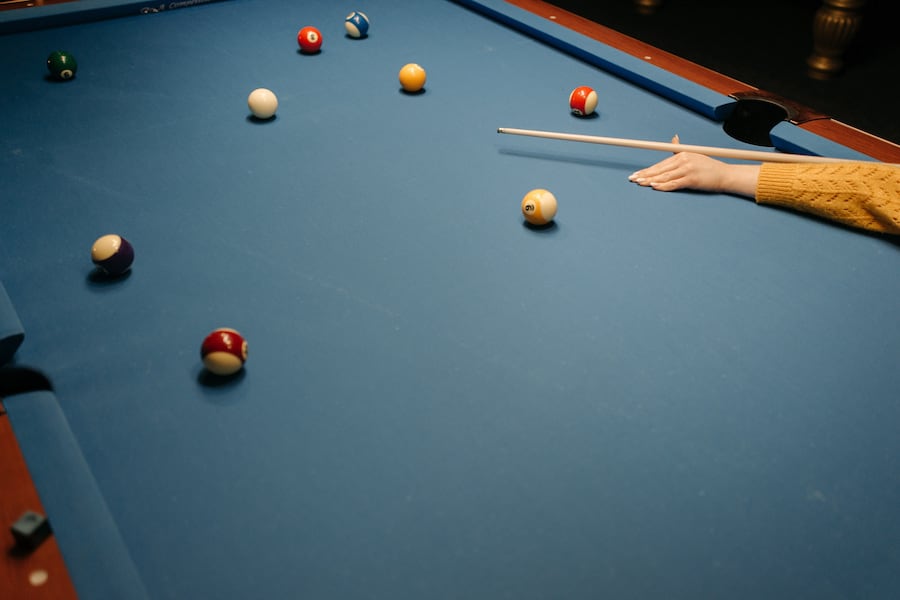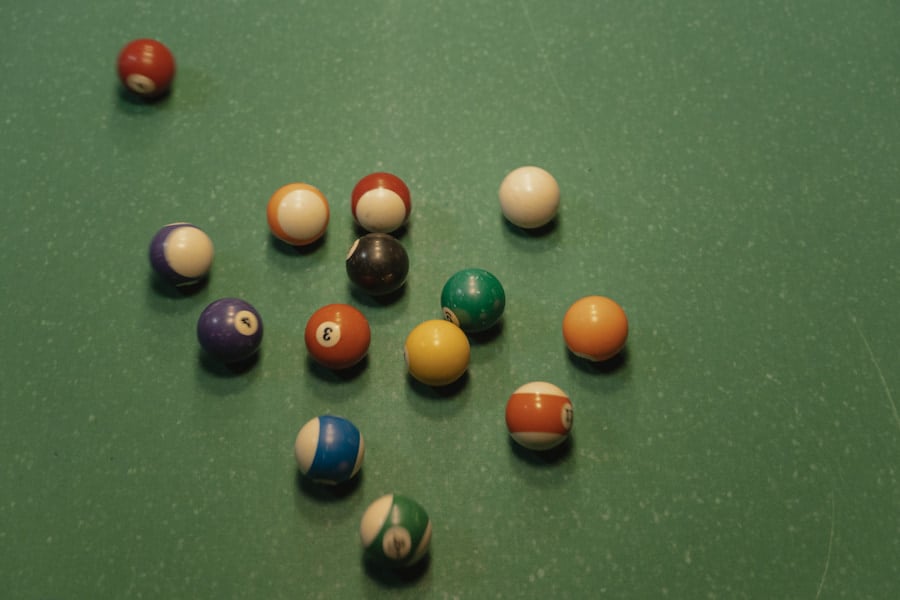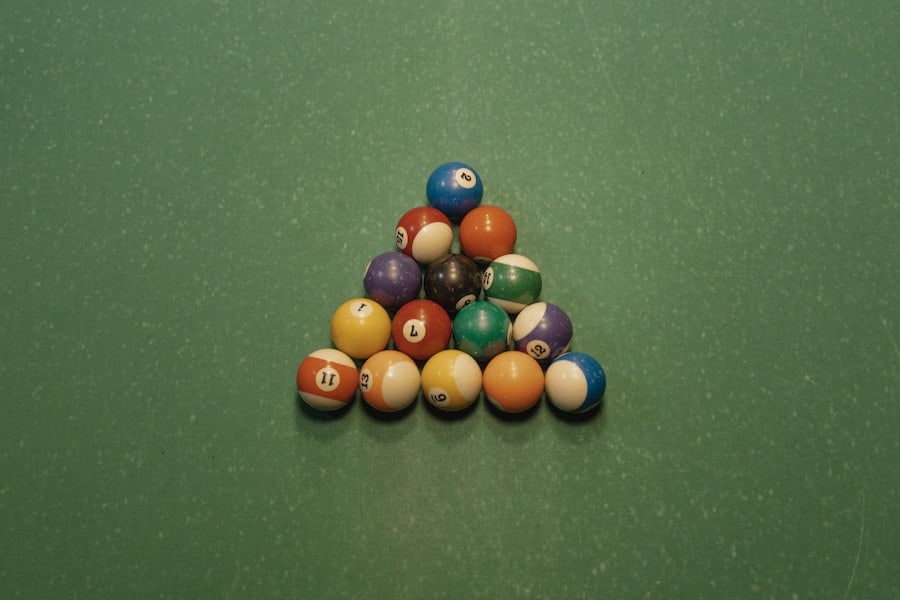As an Amazon Associate we earn from qualifying purchases.
Vintage pool balls are extremely rare nowadays. Most of the materials used in the early days are not used in today’s pool balls so they are unique. If you want to start collecting them, you should know how to identify vintage pool balls to avoid getting fake ones.
How to Identify Vintage Pool Balls
The most basic way to identify vintage pool balls is by identifying what material they are made of. Most modern pool balls are made of phenolic resin which is really durable and you might mistake it for a vintage one.

The easiest to identify through material is wood and stone pool balls. However, it is very rare today to collect even one of them since they stopped production during the use of ivory in the medieval to the renaissance period.
For other pool balls made with different materials, we have specific ways to identify them. These three vintage pool balls are some of the most iconic in pool history and can still be found today.
The Three Popular Vintage Pool Balls
The pool is a very old game and it has undergone many changes in materials that include pool balls. In the earlier years, pool balls were often made in wood, stone, and even ivory.
In the early 20th century, a new synthetic plastic called “Bakelite” was used for making pool balls. It was used until it was soon replaced with acrylic and plastic resin.
Hence, we shall help you identify three of the most known pool balls, namely:
- Vintage ivory pool balls
- Vintage Bakelite pool balls
- Vintage Aramith pool balls
Vintage Ivory Pool Balls
There are still some ivory pool balls laying around antique shops, pawnshops, and even yard sales. Nowadays, ivory is a rare material and is only produced through poaching. Hence, getting one of these vintage pool balls is rare.
To identify ivory pool balls you can either do the following:
- Blacklight test
- Spotting Schreger lines on the pool ball
Blacklight Test
For this test, you will need a reliable long wave black light and dim or darkroom.
- Place the “vintage ivory pool ball” underneath a long wave black light.
- Observe the color of the ball.
- Ivory generally shows yellowish. So do celluloid pool balls.
- To determine if it’s celluloid or ivory, collide it with other pool balls. If it makes a unique sound, it’s a celluloid pool ball.
- Some sellers might also try to incorporate bones or ivory dust on the pool ball so it will show yellow.
- You can dust off or wipe with cloth. If you’re still unsure, have it checked at a local pool shop and see if they can appraise it.
For reference, plastic resin shows the color fluoresce blue or bluish-white.

Spotting Schreger Lines
Schreger lines are marks that are unusually hard in ivory. It is hard to replicate and hence a highly accurate way of identifying ivory pool balls is through this method. You only need a magnifying glass to do this properly.
- Use a magnifying glass to spot for tiny cross-hatched lines.
- Take note of the angle the line makes.
- If the angle is more than 115 degrees then it is genuine elephant ivory.
- If you see a 90 degree angle then you hit the jackpot because it’s mammoth ivory.
Other Ways to Identify Ivory Pool Balls
There are other easy and observable signs that the pool balls are made of ivory. However, this should also be done in combination with either of the two methods above. These are:
- Uneven coloring
- Dark gray or black veining
- Color is yellowish or brownish
- Numbers are engraved on the ball
Vintage Bakelite Pool Balls
As mentioned before, Bakelite is a type of plastic. Hence, some of the methods used for identifying it are simple to do.
Use Hot Water
All you need for this setup is hot water.
- Heat water until it’s hot or have hot water ready with a heater.
- Place the ball inside a heat-resistant plastic container.
- When Bakelite is heated, it exudes a chemical smell similar to that of pungent formaldehyde.
This method is mostly useful if you own the pool balls. Sellers might not want their pool balls subjected to things such as hot water so it’s better to use other methods.
Rub and Sniff
The rub and sniff is a test that has a similar application to using hot water. Hence, you might be able to use it at shops and flea markets.
- Use your thumb to rub the surface of the pool ball.
- Rub the pool ball until you generate heat.
- Smell or sniff the heated surface.
- If it smells like chemical like pungent formaldehyde then it’s Bakelite.

Use 409 Cleaner
For this method, you only need 409 cleaner and cotton swabs.
- Put a small amount of the 409 cleaner on a cotton swab.
- Rub the cotton swab gently and lightly on an unpainted portion of the pool ball.
- Observe the color of the cotton swab.
- If it turns yellow, then it is made of Bakelite.
Do take note, some lacquers and treatments can make this method inaccurate. In most cases, it is highly accurate for identifying Bakelite.
Use Simichrome Polish
This method is similar to 409 cleaner and uses Simichrome polish instead. However, instead of using a cotton swab, use a cloth.
- Apply a small amount of the Simichrome polish into a cloth.
- Rub the cloth onto a clean surface of the pool ball.
- Observe the color of the cloth.
- If it turns yellow, then it is Bakelite.
We recommend doing either the hot water or rub and sniff test after using 409 cleaner or Simichrome polish to eliminate the presence of lacquer.
Vintage Aramith Pool Balls
For Aramith pool balls, you can check our guide for identifying aramith pool balls. The safest option for you would be to check with Aramith website. They can help you identify if your pool balls are made from Aramith and if it’s vintage.
They also have knowledge of what sets they made so you have a better chance of properly identifying a vintage set.
Conclusion
These are some of the most popular and common vintage pool balls around. If you can identify them properly, you get a chance of collecting some of the rare pool ball sets in the world. Ivory and bakelite are some of the pool balls to have.